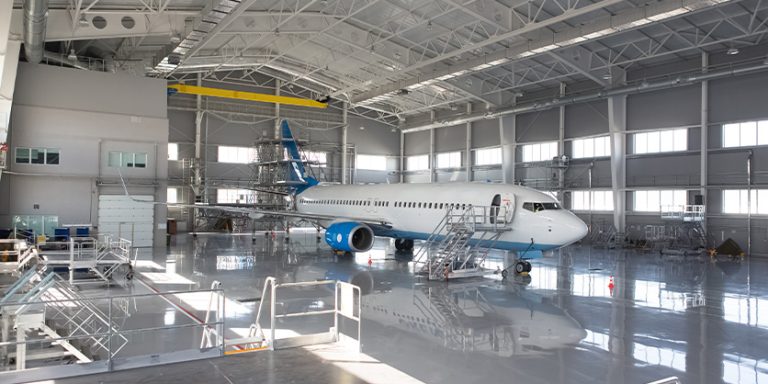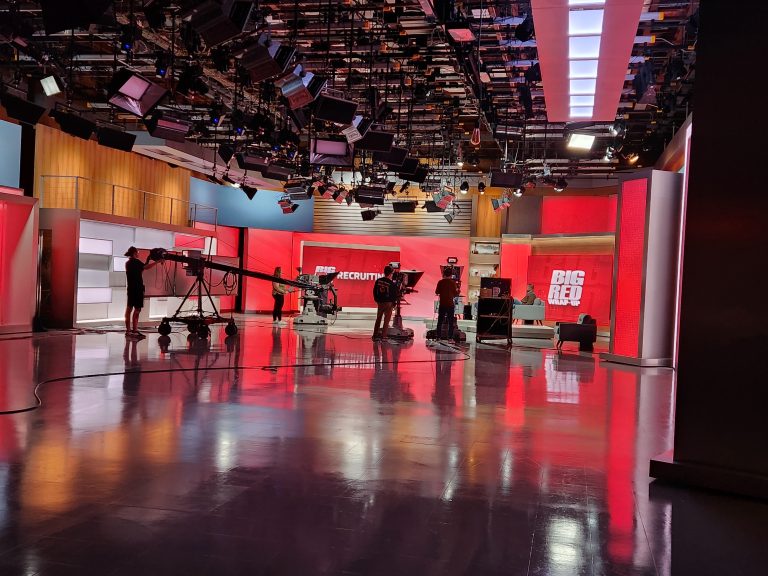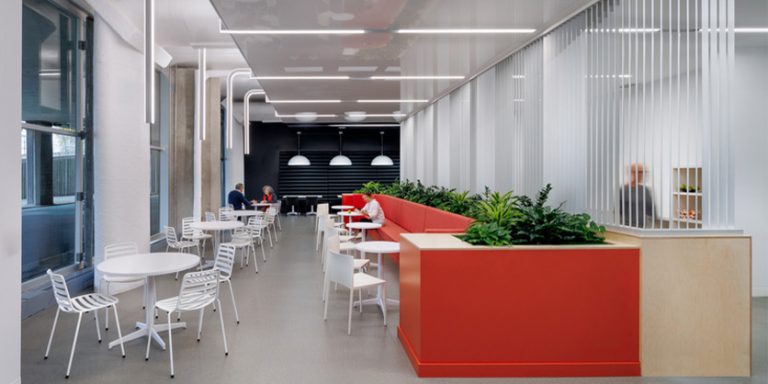New Arts Center Enhances Seniors’ Lifestyle

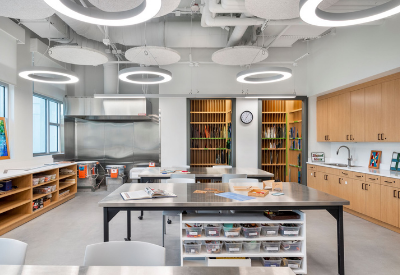 December 21, 2021
December 21, 2021
The 700-acre Shell Point Retirement Community in Fort Myers, Fla. is already an enviable locale for spending one’s golden years, situated a mere 20-minute drive from Sanibel and Captiva Islands. The addition of the recently constructed $25 million, two-story, 44,000-sq.-ft. Tribby Arts Center dedicated to residents’ creative activities is the proverbial jewel in the community’s crown.
Named in honor of resident Maggie Tribby, who donated $10 million to the fundraising campaign, the Center includes a 400-seat theater for musical, theatrical, and educational programming; nine artist studios for activities such as photography, pottery, painting, quilting, stained glass, and other crafts; rotating art galleries; a gift shop; and a café. The Center will eventually host musical and theatrical performances that will be open to the public, although the studios will be reserved for residents only.
Designing a multi-purpose space with an attention-getting grand entrance and atrium was the responsibility of Fort Myers-based Chris Lee, principal architect and president of Christopher J. Lee Architects, Inc. Lee noted that his asymmetrical design for the unconventional building serves as a frame for the artistic collaboration and creation taking place inside.
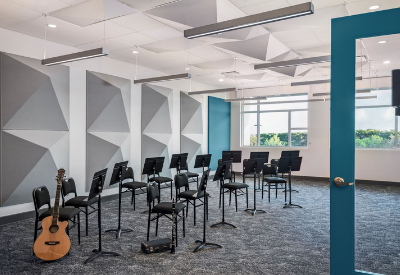
“We saw the increasing value these programs brought to resident life, and we wanted to provide a center that would allow all of the groups to come together in one dedicated space that would encourage and enhance their creative experiences,” said Martin Schappell, Shell Point President & CEO.
The contemporary-style building sets the tone for an industrial-style interior designed by Wegman Design Group, headquartered in Naples. “We really wanted to create this clean and modern environment to act as a backdrop for all of the artists working in this space, while including features that would really inspire them,” notes Amber Caton, Design Director at Wegman Design Group.
The warm design scheme employs neutral whites, grays, and blacks with oak touches throughout the building. In the Grande Lobby, a custom terrazzo pattern was inspired by the kinetic sculptures showcased inside that were also specially created for the space. Installing a glass railing at the second-floor level gives visitors an aerial view of the sculptures from above.
Lighting Challenges
The luminaires chosen for the Center needed to complement the bold architecture and interior design as well as effectively illuminate the many varied installation areas. Caton felt it was essential to have clean-looking fixtures that would bring a balance between form, function, and flexibility.
Additionally, each studio group had their own requests for lighting, including specific lighting temperatures.
For example, the client requested that the lighting in the painting and photography studios be 3500K with a similar ambient lighting temperature. According to Wegman Design Group, the glass painting and pottery studios were designed with diffused downlighting to best illuminate the craft work being done, while the performing arts, music practice, and quilting studios all had uplighting.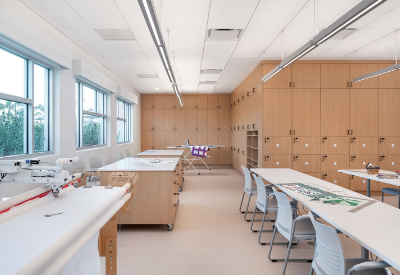
Finding Solutions
To meet these challenges, Bonita Springs, Fla.-based West Coast Lighting specified Axis Lighting’s Sketch pendant in 4000K 90 CRI because its elegant and graceful curves complemented the Center’s clean lines and contemporary design.
Axis’ Sculpt recessed fixtures in 3000K 80 CRI were specified in the artists’ studios and linear fixtures were chosen for their sleek, clean lines and the choice of color temperatures.
What attracted the design team to Axis’ Sketch SurroundLite fixture is the flexibility of the high-efficacy, spherical, three-dimensional wide batwing light distributions and shielding options.
More than an innovative technology to maximize the LEDs, SurroundLite’s design is based on the fundamental physics of how light interacts with matter. According to Colette Fleming, Executive VP/Sales for the Central, Southeast & West Regions at Axis Lighting, the specially engineered lightguide is made of precisely coded and aligned molecules that shape LED output in all three dimensions. SurroundLite’s extra-wide, multidimensional light distribution directs light in all three planes and into every corner of the room — which was perfect for the painting, pottery, and glass studios.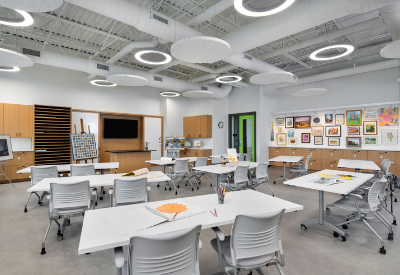
The quilting, crafts, performing arts studios, and music ensemble and music suites are illuminated with Slim SurroundLite fixtures to provide ample lighting and a clean, contemporary look. According to Fleming, what made SurroundLite attractive to the design team is that it offers uniform light distribution on the ceiling. Many ring fixtures don’t offer any kind of [uplighting] optic, or there will be a hot spot directly overhead, which is unattractive and wastes light, Fleming explains.
The low-profile Twig luminaires are an ideal choice for the Center’s low ceilings. In addition, Graze Perfekt’s high-performance wall-grazing optics and the 1.5″-wide aperture proved to be optimal for illuminating the lobby’s Tribby Art Center sign. The luminaire’s innovative and compact linear silicone internal reflection optic delivers a precise, consistent, wide-beam angle (10º x 100º) without color-over-angle artifacts.
Impressive Results
“We were impressed with the range of options that Axis Lighting fixtures provide,” Caton says. “They allowed us to keep a consistent look throughout the spaces, while still addressing each user group’s needs.” Since the luminaires have integral control-ready drivers and a simple optical, electrical, and mechanical connection system, they were easily integrated into the automated building system for control via a smart phone or tablet.
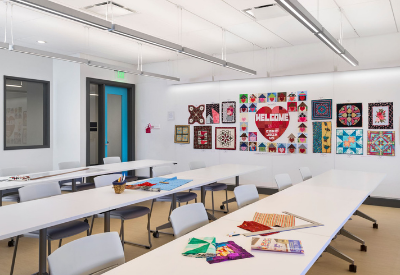
PROJECT TEAM
Architect: Christopher J. Lee Architects Inc.
Engineer: Energy Concepts
Designer:Wegman Design Group
Manufacturers’ Representative: West Coast Lighting
Lighting Manufacturer: Axis Lighting
Photography: Amber Frederiksen Photography


